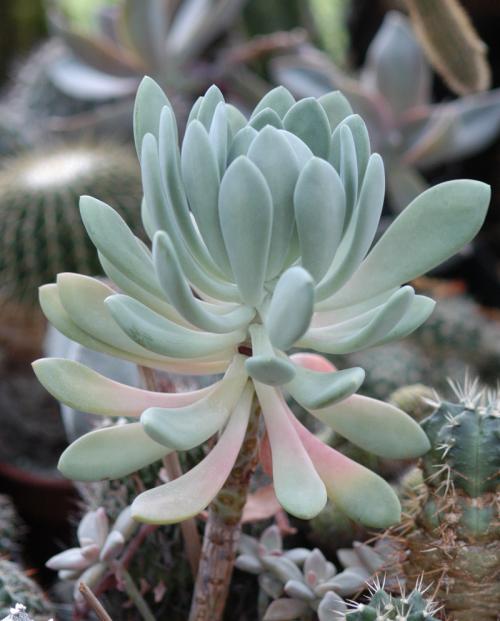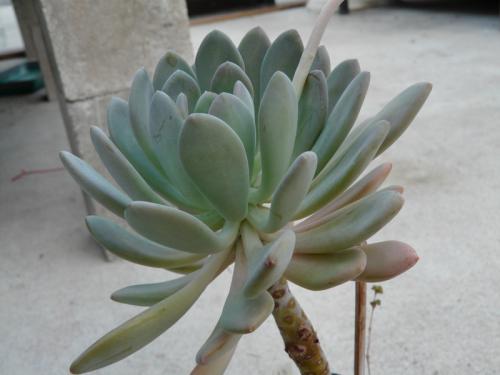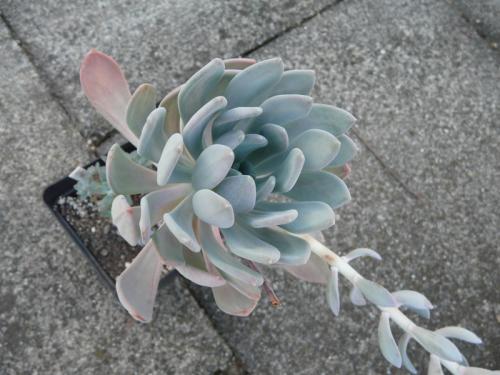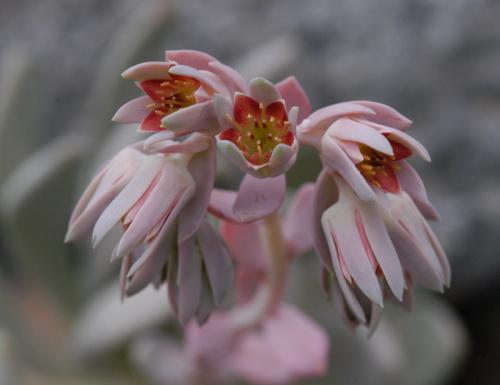Clavata (engl./ fr.)
Origin unknown.
Parentage : Pachyphytum bracteosum x E. sp.
Description (according to J.C. van Keppel, Succulenta, 41, 1962) :
Caulescent plant.
Stem 30 – 40 cm high.
Rosette rather short.
Leaves grey green, up to 10 cm long, in the upper half up to 3 cm wide, elongated to spatulate, almost flat; specially old leaves only slightly pruinose and not or only slightly changing colour in the sun.
Inflorescence : Peduncle green, thick, first upright, later overhanging at the top, 2- or 3- furcate, with 30 – 100 tightly packed flowers, pedicels short, lower bracts shape of leaves, 2 – 4 cm long, still adhering to the peduncle when inflorescence is spent (as with Echeveria gibbiflora), upper bracts thin, after flowering shrivelling and falling off.
Flowers : Sepals unequal, adpressed and longer than petals, petals reddish, paler at the tips, with appendages at the base.
Note :
The plant is common in cultivation but nearly always under the wrong name Echeveria or x Pachyveria ‘Clavifolia’.
x Pachyveria ‘Clavata’ is sometimes confused with x P. ‘Scheideckeri’ because young plants look somewhat similar. Older plants look different: x P. ‘Clavata’ has quite a long stem, the inflorescence is 2- to 3- furcate, the bracts are larger and do not fall off when the inflorescence is spent and the petals have appendages at the base.
x P. ‘Clavata’ resembles x P. ‘Pachyphytoides’ though the latter seems to be larger.
There is also a crested form.
-----------------------------------------------------------------------------------------------------
Origine inconnue.
Parenté : Pachyphytum bracteosum x E. sp.
Description (selon J.C. van Keppel, Succulenta, 41, 1962) :
Plante caulescente.
Tige 30 – 40 cm de haut.
Rosette plutôt courte.
Feuilles gris-vert, jusqu'à 10 cm de long et 3 cm de large dans la partie supérieure, allongée à spatulée, presque plate ; seules les vieilles feuilles sont légèrement pruineuses, et elles ne changent pas de couleur au soleil, ou seulement légèrement.
Inflorescence : Pédoncule vert, épais, d'abord droit, retombant plus tard, en fourche double ou triple, avec 30 – 100 fleurs bien serrées, pédicelles courts, bractées du bas ressemblant à des feuilles, 2 – 4 cm de long, adhérant toujours au pédoncule quand l'inflorescence est fanée (comme chez Echeveria gibbiflora), bractées du haut fines, se fanant et tombant après la floraison.
Fleurs : Sépales inégaux, resserrés et plus longs que les pétales, pétales rougeâtres, plus pâles aux pointes, avec appendices à la base.
Note :
La plante est commune en culture mais très souvent sous le nom erroné d'Echeveria ou x Pachyveria ‘Clavifolia’.
x Pachyveria ‘Clavata’ est parfois confondu avec x P. ‘Scheideckeri’ parce que les jeunes plantes se ressemblent beaucoup. Les plantes plus âgées sont différentes : x P. ‘Clavata’ a une plus longue tige, l'inflorescence se divise en deux ou trois branches, les bractées sont plus grandes et ne tombent pas quand l'inflorescence est fanée, et les pétales ont un appendice à la base.
x P. ‘Clavata’ ressemble à x P. ‘Pachyphytoides’ bien que ce dernier semble plus grand.
Il existe aussi une forme cristée.




Photos Margrit Bischofberger